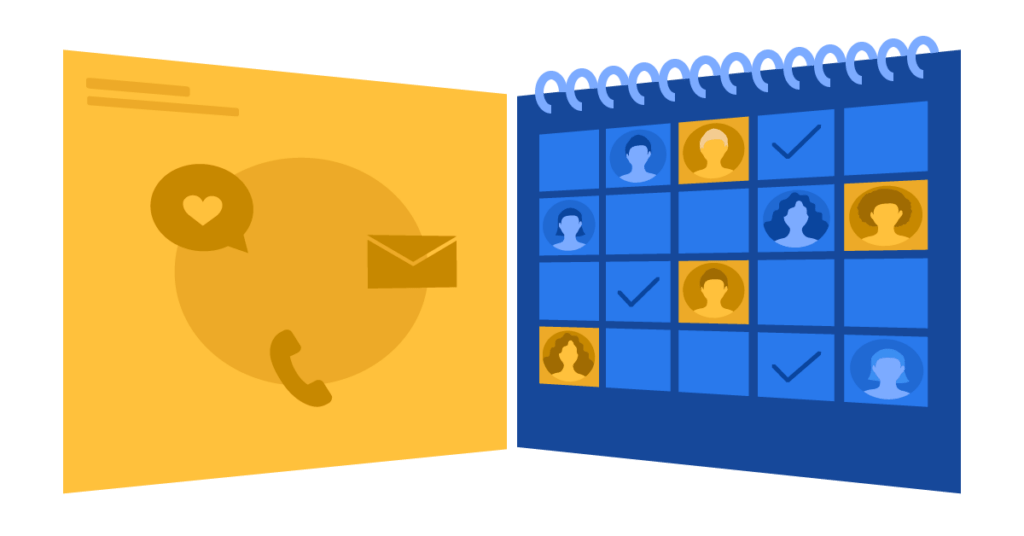Cold outreach is an art form that requires prowess, persistence, and perseverance. When you know how to cold call effectively, it can be a proactive way to steadily bring in leads. Contrary to popular belief, your goal is not to make more calls — it’s to make better connections.
Here is a step-by-step guide on how to cold call
- Understand your ICP
- Understand your product
- Develop your sales talk tracks
- Anticipate objections
- Practice, practice, practice
- Find your targets
- Start tracking your progress
- Start with a strong intro
- State your reason for calling
- Explain what problems you’re trying to solve
- Ask 1-2 CTA questions
- Take strategic notes
- Open your salesman’s calendar link
- Follow up based on your previous conversations
- Record your findings in an SDR Playbook
We’ll be splitting these steps into three phases: before, during, and after the call.

Download the Ultimate B2B Appointment Setting Guide
Download the B2B Appointment Setting Guide to learn how to properly prospect and cold-call best practices.
How to Make a Cold Call
Gone are the days of blindly dialing numbers from a list. When you understand who your prospects are, what they do, and why your outreach matters, they are more likely to engage, advancing them further down the sales pipeline. Start cold calling by understanding what you have to do before you even pick up the phone.
Before the Call
1. Understand your ICP
An ICP, also known as an ideal customer profile, breaks down a few key characteristics that make up your perfect customers. This helps your sales team humanize your target customers so they can better tailor their messaging and practice their talk tracks beforehand.
EBQ Tip: Learn how to create your ICP with our ideal customer profile template. There, you’ll learn how to gather accurate customer data, create a list of suitable companies, and take a data-driven approach to ideating your persona.
2. Understand your product
What makes your offering unique in your market? Why should a customer pick yours over a competitor’s?
Answering these questions helps you clarify your key features and enticing benefits that allow you to create (and practice) your elevator pitch.
A few other questions you can ask yourself include:
- What problems does my solution solve for customers?
- How does my solution save customers time, money, or resources?
- How does my product fit into a prospect’s current workflow?
- What future trends or changes in the market make my solution more valuable now?
3. Develop your sales talk tracks
The best cold calls only last 2-5 minutes. That might sound short, but consider this: a brief, focused call maintains your prospect’s attention and amplifies the impact of your message.
At EBQ, we train our business development reps (BDRs) not to rely on a script. Instead, they familiarize themselves with the clients’ unique product offering and what could get their prospects to bite.
EBQ Tip: Want to see a sample cold call script in action? Check out our Best Cold Call Scripts for Software Sales. We break down a successful call’s structure to demonstrate how to push momentum forward.
4. Anticipate objections
Part of prepping for a cold call is anticipating (and figuring out how to) respond to common objections. Similar to a job interview, familiarizing yourself with your solution’s cutting-edge features and benefits helps you speak confidently on a call.
A few common objections to prepare for are:
- This is too expensive
- I don’t have time to learn a new product
- I’m busy right now
- Just email me the details
- I’m happy with what I have right now
5. Practice, practice, practice
The most successful cold callers are confident, prepared, and tactful. To get there, you simply have to practice.
To start, you should record yourself delivering the elevator pitch to self-evaluate your delivery. Remember: You’re often the face of the prospect’s first impression of your brand, so you need to make sure you come across appropriately.
At EBQ, we also ask our BDR Managers to shadow our reps’ calls to make sure they are following best practices. Reps then get an opportunity to reverse shadow the managers to learn more implicit skills that will help them elevate their next call.
6. Find your targets
At this point, you’re probably anxious to pick up the phone. But who do you call?
If your budget allows it, we recommend investing in a B2B Directory. At EBQ, sales leaders can choose niche data points to segment their prospect list — empowering them to find more relevant prospects right off the bat.
But let’s just say you need to start from scratch. We recommend leveraging the sales prospect list template so you can easily import your list to a CRM in the future. Then, evaluate your current customer database and pinpoint similarities — this helps you identify qualifying criteria as well.
7. Start tracking your progress
Tracking every interaction you have with prospects and customers isn’t just a good idea — it’s a critical process for informing your future outreach and developing data-driven strategies.
To simplify this, invest in a Customer Relationship Management (CRM) platform. A CRM helps your sales team keep a better track of their leads and aligns all your revenue-driving teams. We speak on this in step 12, but you can also use your CRM to record important customer notes to improve your future outreach.

Subscribe to EBQ's Bimonthly Newsletter

Subscribe to EBQ's Bimonthly Newsletter
During the Call
Time to pick up the phone. Remember: Your goal is to kick off conversations — not to mindlessly make dials. Follow the next few steps to find out how to start your conversation strong and how to keep the momentum going.
8. Start with a strong intro
When you first connect with your prospect, state your name, who you are calling from, and ask a quick question.
For example:
“Hi, my name is Donte, and I’m calling from EBQ. How are you doing today?”
We find that presenting a friendly demeanor allows you to build rapport from the get-go as you engage your prospect.
9. State your reason for calling
Before you begin your elevator pitch, make sure you confirm you have the right point of contact.
From there, get to your point as succinctly as possible. These people are often busy, so your goal is to stir up interest rather than forcing a sale.
“I’m reaching out to see if you’re open to scheduling a short conversation next week. I’d love to discuss how EBQ can accelerate your revenue cycle. We’re consistently rated a five-star partner on both Clutch and AppExchange.”
EBQ Tip: Don’t panic if you accidentally connect with the wrong point of contact. Instead, learn to work with these gatekeepers to hopefully convince them to point you to the right decision-maker.
10. Explain the problems you are trying to solve
This is where prospect research becomes key: You can speak to their decision drivers in a couple of sentences to appeal to your audience.
“As you know, marketing campaigns take a lot of manpower to lift off the ground. We provide dedicated, certified, and fractional marketing specialists to ideate, plan, and execute your campaigns — whether it’s a paid search campaign, an SEO-optimized website, or a traditional print sales collateral.”
We find that focusing on getting prospects interested enough to schedule a more in-depth sales meeting is key to a strong cold call. After all, only 2% of first calls end in a sale, so don’t feel too discouraged if your first call didn’t go so well.
11. Ask 1-2 CTA questions
Congratulations! Your prospect is hooked and now wants to learn more about how your solution will address their pain points. Now is the time to ask a few more discovery questions to better prep your next sales call.
A few questions you can ask are:
- What goals are you focused on achieving this quarter?
- Would it be helpful if I shared how we’ve helped similar companies reach great results?
- What is your timeline for implementing a solution?
12. Take strategic notes
Make sure you properly take notes during (or even immediately after) your call. The more context you can provide your sales team, the better.
A few lead summary notes include:
- Who is the point of contact?
- What is their job title?
- Why did they agree to a sales meeting?
- What specific pain points did they mention during the call?
- What are their company’s key characteristics (e.g., size, industry, and targets)?
13. Open your salesman’s calendar link
To warm up a cold lead, you need to strike when the iron is hot. When scheduling the sales call, make sure you have the salesperson’s availability accessible to ensure the smoothest handover process.
After the Call
Did you know that most B2B buyers say “no” four times before they commit? If your prospect goes cold, you can leverage a sales cadence to ensure maximized follow-ups (while minimizing friction).
14. Follow up based on your previous conversations
This is where your note-taking comes into play: use your past notes to inform your current and future touch points. During your follow-up calls, make sure to focus on their pain points and how your solution can properly address their needs.
EBQ Tip: Make sure to leverage a lead rating system. This enables you to quickly sort through your prospects based on their objective interest level, and it can also inform you when you need to follow up with your prospects.
15. Record your findings in an SDR Playbook
Every strong sales process requires you to adapt to your current market landscape. By documenting what has (and hasn’t) worked for your organization, you can rinse, repeat, and readjust your tactics.

Subscribe to EBQ's Bimonthly Newsletter

Subscribe to EBQ's Bimonthly Newsletter
5 Cold Calling Mistakes to Avoid
Even the most experienced BDRs can fall into bad habits that compound into huge lost opportunities. Recognizing these common mistakes can help you refine your approach and boost your chances of booking a sales meeting.
Not coming prepared
You may have noticed how we keep focusing on how to set yourself up for success — and for good reason! Most surveyed salespeople say that a personalized, research-driven approach is key to their effectiveness.
On top of practicing your sales pitch, make sure you are learning how to research your prospects to personalize your talk tracks. We find that tailoring messaging consistently improves effectiveness.
Not listening
Many new BDRs focus so intently on delivering their sales pitch that they forget to listen to their prospects. However, active listening provides opportunities to tailor your pitch and build a genuine relationship. In our experience, the best listen-to-talk ratio is 60:40.
Slowing down and allowing your prospects time to digest and respond helps you maintain control of the call. After all, this should be a two-way conversation that builds rapport and establishes a sense of comfort and trust.
Not mimicking
People tend to trust people who are similar to themselves. Of course, you shouldn’t completely change your entire personality for each prospect, but there is a balance you can strike to mimic your prospects for a smoother conversation.
For example:
If your prospect is
Then you should
Quiet and reserved
Ask minimal small-talk questions
Serious and straightforward
Keep conversations focused strictly on business
Chatty and warm
Engage in light conversation and build rapport before diving into business
Skeptical and cautious
Focus on social proofing by providing facts, case studies, and clear proof points to build trust
Consider recording these personality characteristics in your customer notes so your salesperson can better understand how to approach their upcoming sales calls.
Not keeping it short
No one likes a never-ending lecture. We find that showing respect to your prospects’ limited time by keeping the conversation focused is the best way to minimize the possibility of getting hung up on. Make sure you are not overwhelming your prospect with unnecessary information and concentrate on scheduling a sales call.
Not following up
Did you know that 44% of salespeople never follow up after the first connect attempt? Decision-making prospects are busy, so one conversation is usually not enough.
So when you are following up with your prospect, make sure you focus on adding value with each touch point rather than merely repeating your sales pitch.

Download the Ultimate B2B Appointment Setting Guide
Learn what it takes to identify prospects, get in touch with decision-makers, and set more meetings for your sales reps.
How to Effectively Cold Call
In short, you can effectively cold call by properly training and learning how to customize your talk tracks.
The fifteen steps to success are
- Understand your ICP
- Understand your product
- Develop your sales talk tracks
- Anticipate objections
- Practice, practice, practice
- Find your targets
- Start tracking your progress
- Start with a strong intro
- State your reason for calling
- Explain what problems you’re trying to solve
- Ask 1-2 CTA questions
- Take strategic notes
- Open your salesman’s calendar link
- Follow up based on your previous conversations
- Record your findings in an SDR Playbook
If you need lead generation help, consider checking out our cold calling services. All of our BDRs are trained on our proven processes to make sure they are ready to maximize sales appointments for you. With years of experience across multiple industries, our team knows how to adapt outreach to your unique audience.
About the Author:
Donte is a seasoned sales development expert with 20+ years of experience and has built and trained teams for startups and mid-sized businesses. Joining EBQ in 2015, he advanced from Operations to Revenue Cycle Consultant, leveraging his expertise to help businesses scale revenue. Known for positioning offerings to captivate Ideal Customer Profiles, Donte’s ability to address pain points and decision drivers during sales discussions cements his reputation as an industry leader.


